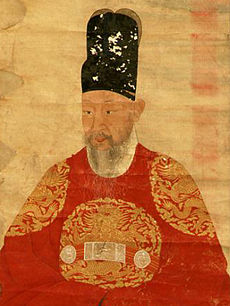Yeongjo of Joseon
| Yeongjo of Joseon | ||||||||
|---|---|---|---|---|---|---|---|---|
 | ||||||||
| Korean name | ||||||||
| ||||||||
| Birth name | ||||||||
|
Yeongjo (1694-1776, r. 1724-1776) was the twenty-first king of the Korean Joseon Dynasty. He was the second son of Sukjong, and succeeded his older brother Gyeongjong.
King Yeongjo was a deeply Confucian monarch, and is said to have had a greater knowledge of the classics than his officials.[citation needed] During the reign of Yeongjo and his grandson Jeongjo, Confucianization was at its height as was economic recovery from the wars of the late sixteenth and early seventeenth centuries.
The king is also famous for having treasured Park Mun-su, who was appointed as Amhaeng-eosa (암행어사) or secret governmental inspectors. Park, who had earned great merit in putting down Yi In-ja's rebellion, went around the nation arresting corrupt local officers in the name of the king.
The only significantly dismal incident during Yeongjo's reign was the forced suicide of his son, the crown prince Sado. Sado most likely suffered from mental illness. He randomly killed people in the palace and was a sexual deviant. Yeongjo refused to kill his son with his own hand and Sado would not follow orders from his father to take his own life. On a hot August day in 1767, Sado finally obeyed his father and climbed into a large wooden rice chest. After eight days, Sado died of suffocation.
Nine years later Yeongjo died and Sado's son Jeongjo became king. Yeongjo was buried in the dynastic tombs at Donggureung.
Yeongjo was the first to take action against Roman Catholic activities in the country. By the 18th century, Catholicism was beginning to acquire a following especially in the Gangwon and Hwanghae provinces. In 1758, Yeongjo officially outlawed Catholicism as an evil practice.
His full posthumous name
- King Yeongjo Jangsun Jihaeng Sundeok Yeongmo Uiryeol Jang-ui Hong-yun Gwang-in Donhui Checheon Geongeuk Seonggong Sinhwa Daeseong Gwang-un Gaetae Giyeong Yomyeong Suncheol Geon-geon Gonyeong Baemyeong Sutong Gyeongryeok Honghyu Junghwa Yungdo Sukjang Changhun Jeongmun Seonmu Huigyeong Hyeonhyo the Great of Korea
- 영조장순지행순덕영모의렬장의홍윤광인돈희체천건극성공신화대성광운개태기영요명순철건건곤영배명수통경력홍휴중화융도숙장창훈정문선무희경현효대왕
- 英祖莊順至行純德英謨毅烈章義洪倫光仁敦禧體天建極聖功神化大成廣運開泰基永堯明舜哲乾健坤寧配命垂統景曆洪休中和隆道肅莊彰勳正文宣武熙敬顯孝大王
See also
- History of Korea
- Rulers of Korea
- Joseon Dynasty
| Preceded by: Gyeongjong |
Rulers of Korea (Joseon Dynasty) 1724–1776 |
Succeeded by: Jeongjo |
Credits
New World Encyclopedia writers and editors rewrote and completed the Wikipedia article in accordance with New World Encyclopedia standards. This article abides by terms of the Creative Commons CC-by-sa 3.0 License (CC-by-sa), which may be used and disseminated with proper attribution. Credit is due under the terms of this license that can reference both the New World Encyclopedia contributors and the selfless volunteer contributors of the Wikimedia Foundation. To cite this article click here for a list of acceptable citing formats.The history of earlier contributions by wikipedians is accessible to researchers here:
The history of this article since it was imported to New World Encyclopedia:
Note: Some restrictions may apply to use of individual images which are separately licensed.